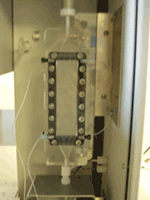More than two years after road access and electrical power to the Mauna Loa Observatory was cut off by lava flows, NOAA staff continue to make critical measurements of the atmosphere and other environmental variables at the remote site.
In 2023, observatory staff installed solar panels at the site and resumed some measurements, including the independent carbon dioxide monitoring programs run by the Global Monitoring Laboratory and Scripps Institution of Oceanography, as well as other atmospheric measurements.
Construction of a temporary road to access the observatory site is anticipated to begin in summer 2025.
Media can contact: Theo Stein (303) 819-7409 (theo.stein@noaa.gov)
Organization(s):
What does this program measure? How does this program work? A modified URG-9000A automated sampler for the collection of semi-continuous ambient samples for analysis of major ions using ion chromatography is used at MLO Why is this research important? The objective is to provide collection and analysis of one year of high-resolution (~hourly) atmospheric gas and particulate phase halide samples. Are there any trends in the data? How does this program fit into the big picture? What is it's role in global climate change? Comments and References |
|





